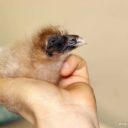Bearded Vulture captive-bred chick at Vallcalent © Hansruedi Weyrich
When a species’ wild population becomes under significant pressure or is at risk of becoming extinct, it is often necessary to intervene to create a captive breeding programme by either managing the population of a species in captivity for breeding or by establishing a new captive population specifically for breeding purposes.
There are different forms of captive breeding programmes, the European Endangered Species Programme (EEP) accredited by the European Association of Zoos and Aquaria (EAZA) is the most intensive type of captive population management of a species. Three of Europe’s four species of vultures have an EEP captive breeding network.
OUR WORK WITH CAPTIVE BREEDING
WHAT DOES MANAGING A CAPTIVE BREEDING PROGRAMME INVOLVE?
With populations of vultures in captivity across zoos, specialised breeding centres and private collections across Europe, the role of coordinating an EEP is vital to ensure the best breeding results for the species’ conservation. This includes working with keepers and curators across the zoos, specialised breeding centres and private collections that house the captive population of vultures. Furthermore, coordinators appoint and work closely with a committee of species-specific experts to set breeding priorities and produce a plan for the future management of the species. They also carry out demographic and genetic analyses of the captive population and produce a Studbook that records all data on hatchings, deaths and transfers of birds within the population.
CAPTIVE BREEDING FOR CONSERVATION
The Vulture Conservation Foundation have over 40 years of experience of breeding vultures in captivity for conservation and coordinates the Bearded Vulture EEP, which managed efforts to breed Bearded Vultures in zoos, specialised breeding centres and private collections since 1976 for release in the wild. These efforts helped restore the species to the Alps mountain chain and in other parts of Europe.
Alongside tackling threats vultures face and improving vultures’ natural habitats, programmes to breed vultures in captivity for release into the wild play an important role in conserving Europe’s species of vultures.
Our team has significant knowledge of vulture breeding behaviour with the Egyptian Vulture EEP and Cinereous Vulture EEP coordinators on our Advisory Board. Using this expertise and our experience, we use captive breeding to reintroduce young vultures to areas where they have disappeared and restock populations of vultures to strengthen local populations or boost genetic diversity in the wild.


